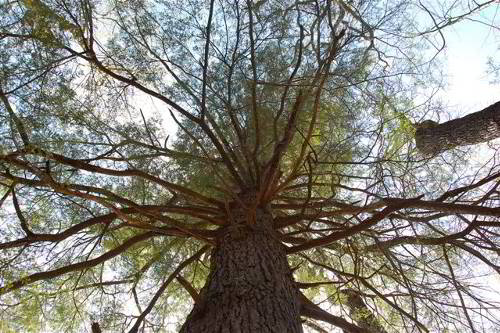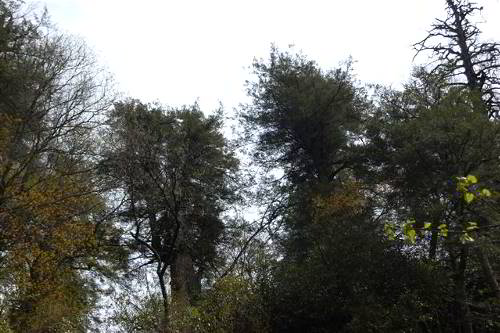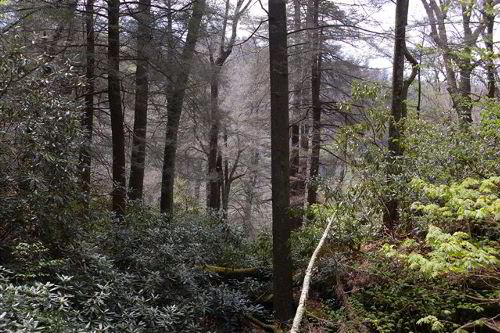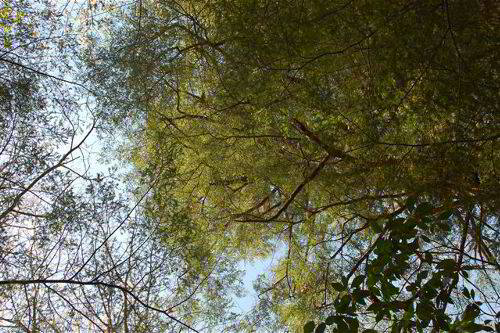|
==============================================================================
TOPIC: Coleman Boundary/Douglas Falls
http://groups.google.com/group/entstrees/browse_thread/thread/3ed86c2e6aefcd78?hl=en
==============================================================================
== 1 of 1 ==
Date: Tues, May 13 2008 10:58 pm
From: James Parton
ENTS,
Due to having Lack Of Work at GE for part of this week I had time to
visit the Coleman Boundary/Big Ivy area of Pisgah National forest
and hike up to Douglas Falls. Upon entering the forest by car I
noticed the hemlocks did not appear healthy. Many looked weak and
dying. I had read of past ENTS reports and others stating that the
hemlocks in this area were still pretty healthy and I wanted to see
if this had changed. It seemed as I went deeper into the forest and
gained in elevation the hemlocks seemed to improve, but not
dramatically. First we stopped at Corner Rock Picnic Area. I noticed
some nice Norway Spruce and White Cedar growing there. It is the
first time I have seen them growing in a forest environment. No
doubt, they had been planted there, years back. I have never seen
White Cedar ( Arborvitae ) this big. They are very pretty trees.
Upon reaching the trailhead of Douglas Falls we set out on our
fairly short hike. Entering the forest I noticed the majority of
trees were not really large or tall indicating that they are second
growth. The forest consists of Maple, Mostly Sugar, Northern Red
Oak, Buckeye, Birch, Black Cherry, some Beech and Eastern Hemlock. I
found no White or Pitch pine at all here.

Eastern Hemlock
I kept my eye out for
American Chestnut sprouts but found not a one here. I found a
12" diameter hemlock that had been cut off the trail and
examined the rings. They were only millimeters apart near the center
and were so close together near the bark that it would have taken a
magnifier to count them. This small hemlock may have been more than
a hundred years old! The bigger ones could be 350 or more years old.

Hemlocks above Douglas Falls
Upon nearing the falls the trees noticeably increase in size
indicating older growth. Several nice ones were found both on and
off the trail. Here, most of the hemlocks are still alive. Some
quite green while others are considerably defoliated. The adelgid is
here and is easily found on the twigs. There is still time for many
of these trees to be saved. If I had the money and the means I would
do it or have it done myself. It is so sad that I am looking at what
may be some of the last living hemlocks here in the east. Green
River Game Land's hemlocks were in slightly better shape than these
are here but like these are in decline. Without man's assistance
they will not last long.

Dying Hemlocks below Douglas Falls
The falls themselves are pretty. One of the few you can walk behind.
Joy really enjoyed seeing Douglas Falls.
Upon getting back to the parking lot we walked across the road into
the woods and found some more hemlocks. One was of good size and
still alive and the other was one of the greenest I have seen.
Treated? Maybe but somehow I don't think so. Up here, some hemlocks
are nearly dead while others a short distance away are quite green.
I don't understand it. But as a general rule the hemlocks are not
looking good.
 Healthy Hemlocks
Healthy Hemlocks
Upon riding back down I was looking for some sizeable chestnut trees
that had been reported to me. I did not find them. I will have to
get back in touch with my informants on the trees location. I might
have walked right by them.
We also hiked a little ways down the Staire Branch Trail but I found
no especially notable trees there.
Here are some measurements taken on the outing. Joy has proven
herself a useful assistant on measuring trees. She writes down the
numbers as I call them out to her and she helps me " spot
" the trunks, if needed. It's cool to have a wife who enjoys
the woods!
CBH Height
Norway Spruce 7' 5" 117.81'
White Cedar 4' 11 1/2" 57. 87'
Eastern Hemlock 12' 2 1/2" 119.14'
Eastern Hemlock 11' 9 1/4"
Eastern Hemlock 124.25'
Eastern Hemlock 11' 6 3/4" 118.25'
Eastern Hemlock 11' 5 3/4"
Buckeye 8' 2 1/2" 123. 97'
Red Oak 9' 4 3/4"
Red Oak 10' 9"
Eastern Hemlock 11' 2 3/4" 101.52'
On average, The trees here do not seem to be as tall as in
Cataloochee Valley or Joyce Kilmer though Jess Riddle and Josh Kelly
found bigger & taller ones down Waterfall and Carter Creeks in a
past outing. James Smith has also expressed an interest in this
area.
http://www.nativetreesociety.org/fieldtrips/north_carolina/waterfall_creek/waterfall_creek.htm
http://www.nativetreesociety.org/fieldtrips/north_carolina/douglas_falls.htm
James Parton
== 2 of 5 ==
Date: Wed, May 14 2008 2:05 pm
From: JamesRobertSmith
Well, those hemlocks look sicker than the last time I was there.
Any idea what it would run to treat the few acres around the falls?
== 3 of 5 ==
Date: Wed, May 14 2008 6:13 pm
From: James Parton
James " Bob " Smith,
I have no idea. Will might be able to answer that one.
James Parton
== 4 of 5 ==
Date: Wed, May 14 2008 8:07 pm
From: Josh
Bill Hascher and I made an effort to treat the area along the
Douglas
Falls Trail, but were denied. There was a beetle release in that
area
and the Forest Service has an unfortunate policy about not allowing
chemical treatment within a 1/2 mile radius of beetle releases. We
are working on getting a service (read: volunteer) contract to treat
some of the area lower down on Waterfall Creek that Jess and I wrote
about in our post. If that permit ever comes through, we could sure
use some volunteers!! It will be a three mile hike, mostly
off-trail,
just to get to the site.
Josh
== 5 of 5 ==
Date: Wed, May 14 2008 9:51 pm
From: James Parton
Josh,
If it ever comes to pass and falls on the weekend, I will volunteer
to
help. Just let me know in advance.
The beetles are probably a lost cause, but I still hope.
James P.
== 2 of 6 ==
Date: Thurs, May 15 2008 5:05 am
From: Kouta Räsänen
James, ENTS,
You mentioned there were Norway Spruces in Coleman Boundary area. If
I
have understood correctly, it is being used in forestry for timber
in
your area and is also naturalized in some areas (right?). Question:
Do
the Norway Spruce have some obvious advantages over your native
conifers as a timber tree?
Kouta
== 3 of 6 ==
Date: Thurs, May 15 2008 8:45 am
From: James Parton
Kouta,
Yes, I found some Norway Spruce at Coleman Boundary. I have never
found any that are naturalized here in NC or planted in large enough
numbers to use for timber. I suppose they could naturalize at higher
altitudes in the Southern Appalachians if planted there, but
surprisingly I found some that apparently germinated from seed on
the
Biltmore Estate. This surprises me since Biltmore is located at only
2,200 feet above sea level. If my memory serves me right, Will told
me
that if Norway Spruce germinates at warmer lower altitudes it does
not
grow well.
Clay Tench, A friend of mine has two planted Norway Spruce trees in
his front yard and one is really close to the woods. Dispite a
search
there I have never found a norway sapling coming up from seed.
I have heard of Norway Spruce naturalizing up in the northern
states.
As far as being used for timber, some of our northern foresters on
the
list might could answer that.
James Parton
== 4 of 6 ==
Date: Thurs, May 15 2008 9:26 am
From:
Yes, Norway spruce regenerates naturally in Wisconsin forests. It
has not yet been aggressively invasive here and is only marginally
successful in maintaining a minor persistent presence in forests
near the plantings where it has been introduced.
Paul Jost
== 5 of 6 ==
Date: Thurs, May 15 2008 4:35 pm
From: JamesRobertSmith
I see lots of Norway spruce when I go to West Virginia. It seems to
be
everywhere along the roads.
|